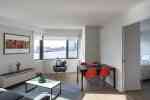The House at Cornell Tech
The House at Cornell Tech is one of the most energy efficient buildings in the world.
The House is part of Cornell Tech's new 2.1 million square foot technology campus on Roosevelt Island in New York City. The building is designed to reinforce the unique model of academic integration, multi-disciplinary research, and collaboration at the core of the Cornell Tech mission. It serves as a lively and comfortable living place for informal social interactions between students and faculty while they reside on campus.
The Cornell Tech campus itself is a ground-breaking concept, combining the innovative capacity of Silicon Valley with the financial power of Wall Street to help strengthen and transform the city's economy. The House, the residential component of the campus, was designed to Passive House standards, which drastically reduces energy consumption while creating a healthier and more comfortable living environment for a fraction of residents’ usual energy costs.
The House was the largest and tallest residential building in the world built to Passive House standards when it completed in 2017.
The House is the tallest building on Cornell Tech’s campus and an iconic marker.
The building’s exterior shimmers, using a state-of-the-art, color-changing paint that, when reflecting light, naturally shifts color from silver to warm champagne. The façade, constructed of a prefabricated metal panel system, acts as a thermally insulated blanket wrapping the building structure. The wrap ends in a louver system that extends the entire height of the building. This reveal is designed to be the “gills” of the building, providing an enclosed, louvered exterior space where the heating and cooling equipment live, allowing the building systems to breathe.
Purified fresh air is ducted into each bedroom and living room, providing superior indoor air quality. Use of low VOC-paint, which limits off-gassing and also improves indoor air quality, is used throughout the building, among many other elements. Compared to conventional construction, the building is projected to save 882 tons of CO2 per year, equal to planting 5,300 new trees.



Interiors are designed to provide a comfortable living experience that reinforces the social and intellectual connectivity that is at the heart of the school’s mission.
The interiors approach is geared to further a dynamic environment in which students and faculty can benefit from the synergy of their peers. The building features a number of collaborative spaces, both inside and outside, to facilitate collective academic creativity.

“Constructing the first Passive House residential high rise in the world is the latest and most exciting example of our effort to set new benchmarks in sustainability and innovation. We hope this will serve as a model for how Passive House standards can be brought to scale in the United States and create a new template for green design here in New York City.”
Daniel Huttenlocher | Dean, Cornell Tech
Designing, Detailing, and Building The House at Cornell Tech
Take a detailed look at The House at Cornell Tech.
View Case Study










